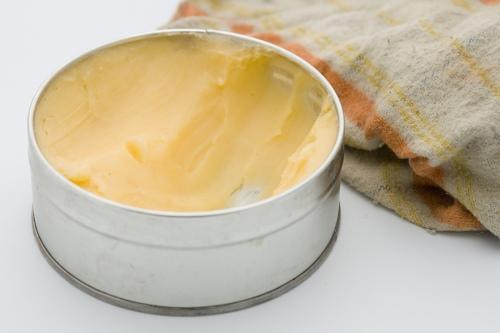Apply Waxes to Wood Furniture for a Layer of Shine but not for a Durable Protective Layer
Wax is a substance that is used to improve the shine of antique wood finishes. It hides and fills minor scratches and it adds a minimal layer of protection to wood.
Wax can be used on most types of woods but should not be applied over glossy finishes. Also, waxes that contain strong solvents can cause damage to wood so make sure to inspect the ingredients of the wax before applying it.
Applying Natural, Neutral and Colored Wax
When selecting a shade of wax to apply to wood furniture you have the choice of natural, neutral or colored wax. It is not recommended that natural or neutral colored wax be applied to dark wood because they will leave a light-colored residue on the wood that will not look right. Use dark-colored wax on dark wood and light-colored, natural or neutral wax on light wood.
Paste Wax and Beeswax
Furniture wax comes in two basic varieties: paste wax and beeswax. Neither type provides much protection for wood. And, both allow water and moisture to soak through them. Wax is primarily used to make a piece of wood furniture look good – while providing a minimal amount of protection from scratches.
Contrary to popular belief, wax should not be applied as a wood cleaner. Rubbing wax onto wood and then buffing the wax does not remove dirt and grime. Instead, it will simply loosen the dirt that is on the wood. The dirt will become mixed into the wax and remain on the surface of the furniture after the wax dries. Therefore, it is important to clean wood furniture with mineral spirits before applying any type of wax.
Applying Waxes to Antique Furniture
Adding a layer of wax to a piece of furniture is easy. Follow these simple steps for the best results:
- Thoroughly clean the wood with mineral spirits and a cotton cloth.
- Grab a lump of wax from its container using a cotton cloth.
- Place the wax in the center of the cloth.
- Rub the wax-filled cloth over all surfaces of the furniture.
- Allow the wax to dry (exact amount of time will vary depending on the specific type of wax and the temperature and humidity in the area where the waxing is taking place).
- Using a clean cotton cloth, buff the furniture until the wax disappears.
- Continue buffing in circular motions until the furniture shines.
Furniture can be re-waxed as often as necessary. The term “wax build-up” is not a concern because every time wax is used, almost all of the wax is removed during the buffing process.
Using a Wax Stick to Fix Dents
When small scratches, gouges and dents exist on antique furniture they can be repaired with wax. There are varieties of colored wax sticks available at hardware stores that can be used to fill the damaged areas. To apply, simply rub the wax stick over the affected area until it is filled. Then, buff the area until it blends. Note: wax is not recommended for fixing damage on corners or edges of furniture because these areas usually see more wear than flat surfaces. If you want to apply wax on a corner or edge, be aware that it may require frequent re-applications.

